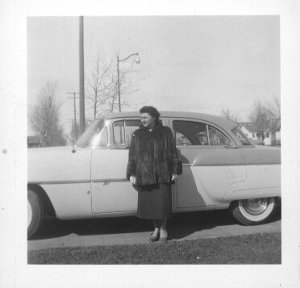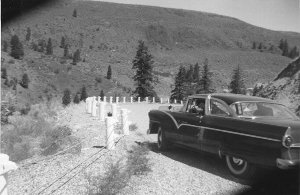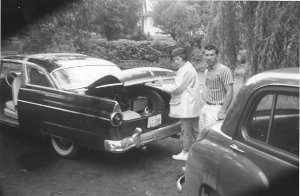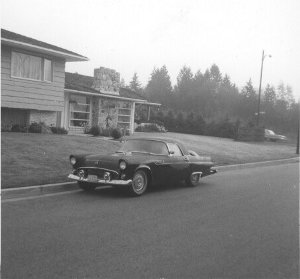Happy Days – the Car in the 1950s and 60s
The Voss Family
by: Edward Vaughan
March 2009
My Grandparents have seen it all. The seatbelt, cruise control, airbags, electronic fuel injection system; my grandparents have lived through these innovative and groundbreaking inventions which we give no second though about in today’s automobiles.1 They were once teenagers, racing around town in their parent’s cars, going to movies with friends, drinking at the bar on the weekends, acting just as today’s adolescents. The automobile allowed their generation to leave home. They were able to leave home on the weekends and weeknights, go socialize at drive-in movies, go out on dates, do things that gave them the freedom to do whatever they wanted away from the watchful eye of their parents. The 1950’s and 60’s saw drastic changes in the actions of its youth. The counter culture movement promoted freethinking and a ‘do whatever, whenever’ attitude amongst Canada’s youth. This paper will discuss the 1950’s and 60’s when my grandparents transitioned from their lives living at home to their lives as spontaneous and adventurous individuals making their way in the world. I will put an emphasis on the differences between today’s youth and the adolescent years of my Grandparents. Based on interviews with my grandparents, I will discuss the similarities and differences between growing up in the 50’s and 60’s compared to growing up in the 21st century.
Bill Voss: (December 27, 1935 – 1951):
My Grandfather William Voss was born on December 27, 1935 in Wilkie, Saskatchewan. When he was born his parents, Hermann Voss and Elsie Voss, owned a 1929 Ford Model A. It was a soft top and therefore could not be used in the wintertime. My Granddad grew up on a farm and his family relied heavily on the automobile as a means to keep their farm running. While at school his father would work around the house: feed the animals, milk the cows, pick the eggs, and on Saturdays would travel with his entire family into Wilkie to sell the cream and eggs to the local stores.2 While in town they would also stock up on supplies, for they would not be going back into town until the next weekend.3 The road to Wilkie was about 9 miles long, which usually took about 45 min to travel, and was spotted with potholes and narrow passages.4 Once you got within the city limits the roads became much smoother and well maintained. Once all the chores and routines of the day were finished, the whole family would drive to the local diner and get steak hamburgers with mash potatoes and gravy.5 Like most families, the Voss’s would plan their entire day around the vehicle. The only other time my Granddads family used the automobile was to drive to Church on Sundays. For the rest of the week the automobile would not be used.6
To escape the daily routine of work and school, my Granddads family would go on vacation once a year during the summer. With their 1929 Ford Model A, the family would pack up some clothes for the weekend and travel north to Battleford, Saskatchewan for the Battleford Fair. Battleford is a small town about 50 miles north of Wilkie and would take about 1 ½ - 2 hours.7 During the summer of 1953 when my Granddad was 18 years old, he worked on the railroad. He would take his family’s Ford Model A, which wasn’t being used during the week, and travel 15 miles out of town to Thakery, Saskatchewan. Five days a week my granddad drove over an hour in the morning to work so that he could have spending money when we went off to school to play hockey in September.8
Denise Voss: (September 10, 1937 – 1957):
My Grandmother, Denise Voss, was born to Frederick Raymond (F.R.) Whittick and Mary Whittick on September 10, 1937 in Rosland, British Columbia. Her father worked for Comingco Smeltering Company, which is still active today, and later opened up his own plumbing company. While F.R. was at work, Mary Whittick would stay at home with my Granny, her two sisters and two brothers. The Wittick Family owned a 1939 Ford Model T and F.R. was the principle driver of the vehicle. He would use the truck for work during the week and for pleasure on the weekends.9 When Denise was 3 years old, the Wittick family moved to Leathbridge, Alberta, where they bought a nicer home in the suburbs. This was where F.R. opened up his plumbing business, Wittick Brothers Plumbing. While F.R. was at work, my Granny and her siblings would have to walk to school everyday and her mother would have to walk to grab groceries or do any chores in town.10 Since the Whittick family had only one vehicle while Granny was growing up, it would be used strictly for business except on the weekends. It was very common for families living in suburban neighborhoods that the father use the automobile to travel to and from work that was located in the ‘Central Business District’ near the city center.11 For both of my Grandparents, walking was no big deal when growing up. They would never think about the distance or how long it took to walk anywhere because they were not use to the everyday use of the automobile unlike today society.12 If it took about an hour to walk to the grocery store, you didn’t think about the distance, it was just something that needed to be done. Unfortunately, we are so reliant on the automobile these days that we use it for very menial jobs.
While growing up in Leathbridge, my Granny lived in a very traditional Victorian household. Her father went out and supplied the livelihood for the family while her mother stayed at home and took care of the children. Growing up, my Granny was never given a car to use once she got her drivers license in 1957. It was very rare that families would give their children cars to have or use everyday.13 If she were lucky, she would be allowed to use her fathers 1945 Packard or his 1955 Thunderbird, but never more than once times a week.14 In 1953, at the age of 16, my Granny worked at Crestkeys as a key cutter and would have to use the transit bus to get to and from work.15 Fortunately, her car-less days were a thing of her past once she met my Granddad in 1953.
The Voss Relationship: 1957:
On one fall evening in 1953, Bill Voss met Denise Voss and the rest is history so to speak. They met after a YMCA dance in Leathbridge where some of their friends all jumped into one of my Granddads friends’ car and went out for food. After dating for four years, when my Granny was 20 and my granddad was 22, they ran away to the United States and got married. They drove down to Calispell, Montana, in my Granddads brand new 1957 Crown Victoria that he had bought for about $4,000.17 Unlike my Granddad, it was very common for people to buy their automobiles on credit. Although automobiles were cheap, they were not always affordable for everyone. Credit allowed people to make monthly payments to their vehicle while they were driving and using the automobile. My Granddad was playing junior professional hockey during this time and was being paid to do it, therefore he was able to afford a vehicle at a young age. My Granny and Granddad came back up to Canada after the wedding and moved first to Drumheller and later to Calgary where they would eventually settle and raise their family. Although married at a young age, my Granddad was still surrounded by the male comradely that hockey provided.
My Granddad and his teammates would drive around town drinking beers and grabbing food at the local fast food joints almost every weekend.20 Playing for the Concordia College Hockey Team in Lethbridge during high school, you were treated very well by the school and the city. This continued into his junior hockey career. If, while celebrating the game, the police pulled you over and you had been drinking, they would put you in the back of their car and take you home, with little or no fuss.21 While playing hockey in Drumheller, the team, after a home game victory, was given boxes of beer and they would drink some of it while driving home. If a game was in another city you still drove home, sometimes 1 – 2 hours, while drinking beer.22 Once again, the best part was that police officers rarely enforced the ‘no drinking’ law.23 If the team was caught drinking and driving in Drumheller, the police would always give the team preferential treatment. Therefore they rarely worried about the police.24 After one away game in Fernie, British Columbia, my Granddad and some of his teammates would finish their beer bottles, reach out and over the car, and throw the empty bottles across the road and try to hit the signs moving past.25 This type of social behavior would never be acceptable or permitted on today’s roads. Laws are in place to prevent this type of reckless driving today and there are very hefty fines and penalties for engaging in such wild activities while driving. Today, adolescents take part in reckless driving practices due to the impact of peer pressure by their fellow peers. Research has recognized that adolescents driving behavior depends on who is in the car with them.26 When teens are driving, they drive faster and take more risks when carrying peers over adults.27 When you get a car full of hockey players and throw alcohol in the mix, these social pressures were non-existent.28 There was no ‘cool’ image my Granddad was trying to portray to his teammates while driving the car; him and his buddies were just having fun. With today’s youth, you’re bound to have pressures on the driver to drive more crazy and reckless, no matter where you live.
In my grandfather’s case, the driver would always be responsible enough not to get drunk and drive after the hockey games. Especially when they would drive south across the U.S. boarder and illegally smuggle alcohol back into Canada. During the 1960’s, my Granddad and some of his teammates would drive down to Blane, Montana, in his 1963 Studebaker, hang out in one of the local pubs, buy booze when leaving town, and bring the beer back over the boarder. They would hide the booze under the hood near the wheel wells and pass by the boarder patrol with no problem. Both my Granddad and Granny would never think of drinking and driving or smuggling beer as a bad thing during their adolescence.29 Sure, if caught there would be consequences, but when your with your friends having fun and pushing the limits, you never think about what might or could happen, you just did it.
For rural and urban dwellers, the automobile was becoming a basic social necessity.30 A very popular activity during my grandparent’s adolescents was going to the local drive in Movie Theater. It was very popular amongst Leathbridges’ youth. All of Granddad and Granny’s friends would drive to the theater, park in a row together, roll down the windows, and talk down all the cars.31 The combination in each car was usually couples. When alone, my grandparents would show up extra early to grab an end spot so that they had access to two speakers instead of one.32 The drive in Movie Theater was the equivalent to a house party today. Friends, girlfriends and boyfriends, teammates; they all would get together in a social setting, maybe drink the odd alcoholic beverage, and have fun late into the night. While out with your friends, you felt no need to prove yourself because you were apart of a tight group of friends and there was no need to prove yourself unlike today’s adolescents. Today, those who are considered the ‘popular’ kids in school or play on a city sports team are actually more prone to peer influence over those who are less ‘popular.’33 This peer pressure could potentially lead to the increases in the number of car races late at night or even increases in car crashes. Again, my grandparents didn’t have the social pressures of being popular during their adolescents because popularity was not an issue amongst my Grandparents friends.
When looking back, my Grandparents have lived through many changes when it comes to the car. Automobiles changed the way my Grandparents generation spent their weekends and varied the ways they interact with their friends. The automobile allowed my Grandparents to pursue independent mobility that changed so many aspects of their lives. Whether it was my Granddad and his teammates drinking and driving home from an away game celebrating a victory or both my grandparents running away to get married, the automobile had brought so many opportunities and exciting experiences into their lives. Today, choices made by teens and young adults have much larger consequences on their lives when dealing with the automobile. Although the use of the automobile has allowed many teens and young adults the mobility to interact and socialize with friends, some social behaviors by teens in the 50’s and 60’s are regarded as much more serious today than back then.
Bibliography:
“Automoible – Timeline,” Greatest Engineering Achievements in the 20th Century http://www.greatachievements.org/?id=3880 (17 March 2009).
Bill Voss, personal interview, 18 March 2009.
Bill Voss, personal interview, 22 March 2009.
Denise Voss, personal interview, 18 March 2009.
Denise Voss, personal interview, 22 March 2009.
Interrante, Joseph. “The Road to Autopia,” in The Automobile and American Culture, edited by David L. Lewis and Lawrence Goldstein.
Joseph P. Allen and Bradford Brown, “Adolescents, Peers, and Motor Vehicles: The Perfect Storm?” American Journal of Preventive Medicine, Vol. 35, Iss. 3 (September 2008).
Photograph’s:
Denise Voss, Bill Voss’s 1955 Thunderbird, 1960, Vancouver, British Columbia.
Denise Voss, Crown Victoria in the Glacier National Park, Montana, July 1957, Outside of Calispell, Montana.
Frederick Whittick, Whittick’s 1945 Packard, 1948, Leathbridge, Alberta.
June Whittick, Packing to go to Trail, British Columbia, July 7, 1957, Vancouver, British Columbia.
Endnotes
1 “Automoible – Timeline,” Greatest Engineering Achievements in the 20th Century http://www.greatachievements.org/?id=3880 (17 March 2009).
2 Bill Voss, personal interview, 18 March 2009.
3 Ibid.
4 Ibid.
5 Ibid.
6 Ibid.
7 Bill Voss, personal interview, 18 March 2009.
8 Ibid.
9 Denise Voss, personal interview, 18 March 2009.
10 Denise Voss, personal interview, 18 March 2009.
11 Interrante, Joseph. “The Road to Autopia,” in The Automobile and American Culture, edited by David L. Lewis and Lawrence Goldstein, 95.
12 Bill Voss, personal interview, 18 March 2009.
13 Denise Voss, personal interview, 22 March 2009.
14 Ibid.
15 Denise Voss, personal interview, 22 March 2009.
16 Frederick Whittick, Whittick’s 1945 Packard, 1948, Leathbridge, Alberta.
17 Bill Voss, personal interview, 22 March 2009.
18 Denise Voss, Crown Victoria in the Glacier National Park, Montana, July 1957, Outside of Calispell, Montana.
19 June Whittick, Packing to go to Trail, British Columbia, July 7, 1957, Vancouver, British Colombia.
20 Bill Voss, personal interview, 18 March 2009.
21 Ibid.
22 Bill Voss, personal interview, 18 March 2009.
23 Ibid.
24 Bill Voss, personal interview, 22 March 2009.
25 Bill Voss, personal interview, 18 March 2009.
26 Joseph P. Allen and Bradford Brown, “Adolescents, Peers, and Motor Vehicles: The Perfect Storm?” American Journal of Preventive Medicine, Vol. 35, Iss. 3
(September 2008): S289.
27 Ibid., S289.
28 Bill Voss, personal interview, 22 March 2009.
29 Denise Voss, personal interview, 18 March 2009.
30 Interrante, “Autopia,” 89.
31 Denise Voss, personal interview, 18 March 2009.
32 Bill Voss, personal interview, 18 March 2009.
33 Allen and Brown, “Adolescents,” S290.
34 Denise Voss, Bill Voss’s 1955 Thunderbird, 1960, Vancouver, British Colombia.



